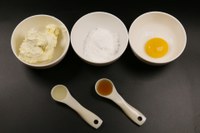Prairie Fare: What Ingredient Swaps Work in Recipes?
(Click an image below to view a high-resolution image that can be downloaded)
By Julie Garden-Robinson, Food and Nutrition Specialist
NDSU Extension
“I made your recipe, but mine doesn’t look anything like the photo,” the caller said.
“I’m not sure what happened,” she added.
After we talked a while, I figured out the rest of the story.
She was making a muffin recipe, but she was missing a few ingredients in her cupboard. She began substituting the recipe ingredients with other items she had on hand.
I counted five swaps as she described what she made. She had invented a new recipe.
She said the end product was “edible.” She laughed as we visited about her kitchen experimentation.
She said she would give the recipe another try after she picked up the actual ingredients.
Cooking allows more latitude for creativity than baking. Most of us add “this and that” as we cook. We all have different taste preferences. However, when you bake, you are a scientist with less room for experimenting.
As we move toward the holiday season, many people find their family-favorite cookie, muffin and bread recipes. Keeping holiday traditions is an excellent way to bind generations to each other.
If you want the family recipe to be the “same” as your memory of it, take some steps. Before you begin food preparation, check your ingredient supply.
I usually line up the dry ingredients with the recipe on my counter. I doublecheck the perishable ingredients in the refrigerator.
Keeping a grocery list is particularly beneficial. However, sometimes we need extra reminders in my home. For critical ingredients for an upcoming meal, we put the empty package on the counter where it serves as a visual reminder. We recycle the empty package when we replace the ingredient.
Even with planning, you may run low on items. Making a trip to the grocery store may be inconvenient.
Most recipes are a bit “forgiving” of one substitution. However, the final recipe probably won’t have exactly the same texture or taste as the original.
From allspice to yogurt, we have a comprehensive guide available by searching online for “NDSU Extension Ingredient Substitutions.”
These are a few scenarios with swaps from the Ingredient Substitutions guide:
- A biscuit recipe calls for 1 cup of self-rising flour. You can swap the self-rising flour with 1 cup minus 2 teaspoons all-purpose flour plus 1 1/2 teaspoons baking powder and 1/2 teaspoon salt.
- You are making a dip recipe that calls for 1 tablespoon fresh dill. You can swap in 1 teaspoon of dried dill.
- A muffin recipe calls for 1 teaspoon pumpkin pie spice. You have a lot of spices but not that one. You can replace 1 teaspoon of pumpkin pie spice with 1/2 teaspoon cinnamon, 1/4 teaspoon ginger, 1/8 teaspoon allspice and 1/8 teaspoon nutmeg.
- A meatloaf recipe calls for one small onion. The grocery store is a few miles away. You can swap 1 to 2 tablespoons minced dry onion or 1 teaspoon onion powder for the fresh onion.
- You decide to make buttermilk pancakes, but you are surprised that you have only a tablespoon of buttermilk. For each one cup of buttermilk, use one cup of regular milk then remove one tablespoon of milk and add 1 tablespoon lemon juice. If you do not have lemon juice, you may use 1 tablespoon of vinegar.
This week’s recipe can become a gift mix in a jar, or it can be baked right away. For a version with printable recipe cards and photos, see bit.ly/quickbreadmix. The guide also features herb quick bread, peanut butter bread and cherry-chocolate scone mixes that can be assembled as gift mixes.
Snickerdoodle Muffins (Muffadoodles) (Gift Mix in a Jar)
1 cup sugar
3/4 teaspoon baking soda
3/4 teaspoon baking powder
3/4 teaspoon cream of tartar
3/4 teaspoon ground nutmeg
1/2 teaspoon ground cinnamon
1 1/2 cups all-purpose white flour
3/4 cup whole-wheat flour
Muffin topping: 5 teaspoons additional sugar and 1 teaspoon ground cinnamon mixed together to sprinkle on top of muffins (1/2 teaspoon per muffin); place in a snack-size zip-top bag in jar.
In a clean quart-sized jar, layer all ingredients except the 5 teaspoons additional sugar and 1 teaspoon cinnamon. Place additional sugar cinnamon mixture in a small plastic bag and place on top of other ingredients. Cover the jar tightly with a lid, decorate if desired and attach a copy of the recipe card.
Snickerdoodle Muffins (Muffadoodles) Recipe Card
1 recipe Snickerdoodle Muffin mix
Add additional ingredients:
1 cup (2 sticks) margarine or butter
2 teaspoons vanilla extract
2 eggs
11/4 cup Greek yogurt (plain, nonfat)
Preheat oven to 350 F. Combine wet ingredients (margarine or butter, Greek yogurt, eggs and vanilla) in one bowl. Combine dry ingredients (sugar, baking soda, baking powder, cream of tartar, ground nutmeg, ground cinnamon, all-purpose white flour and whole-wheat flour) in a separate bowl. Fold the dry ingredients into the wet ingredients until dry ingredients are well mixed. Make sure not to overmix muffins. The batter may be lumpy. Scoop muffin batter into muffin tins until the batter fills roughly three-fourths of the muffin tin. Stir together additional sugar and cinnamon and sprinkle 1/2 teaspoon on each muffin. Bake for 20 to 22 minutes or until they are golden brown.
Makes approximately 12 servings (one muffin each). Each serving has 180 calories, 9 grams (g) fat, 3 g protein, 23 g carbohydrate, 1 g fiber and 130 milligrams sodium.
Julie Garden-Robinson, Ph.D., R.D., L.R.D., is a North Dakota State University Extension food and nutrition specialist and professor in the Department of Health, Nutrition and Exercise Sciences. Follow her on Twitter @jgardenrobinson)
NDSU Agriculture Communication – Dec. 2, 2021
Source: Julie Garden-Robinson, 701-231-7187, julie.garden-robinson@ndsu.edu
Editor: Elizabeth Cronin, 701-231-5391, elizabeth.cronin@ndsu.edu




